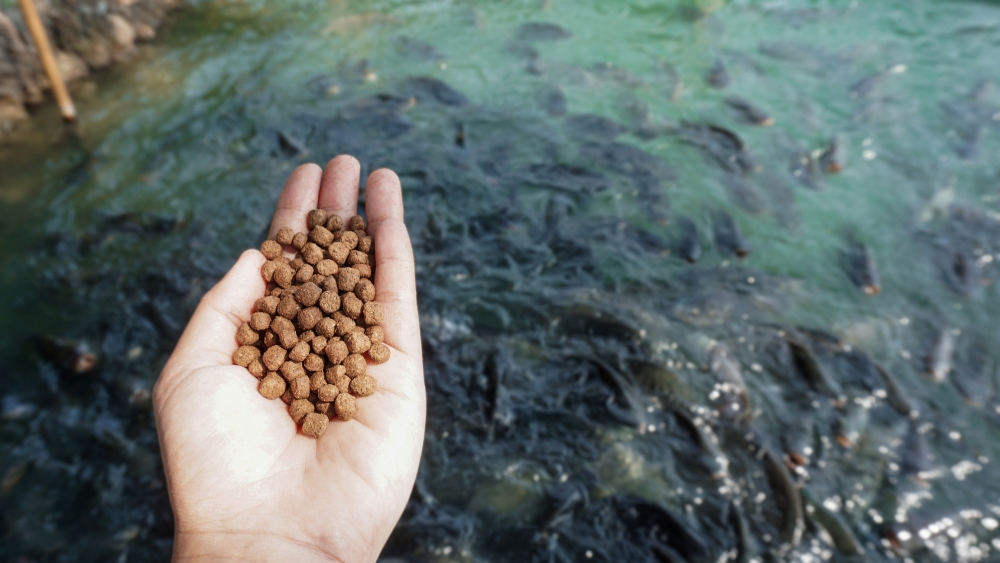
A Tangled Food Web

Born in food web ecology, the concept of trophic levels — the hierarchy of who eats who in the natural world — is an elegant way to understand how biomass and energy move through a natural system. It’s only natural that the idea found its way into the realm of aquaculture, where marine and freshwater farmers try to maximize their product with efficient inputs.
“It’s often used as a measure of how sustainable it is to harvest or consume that species,” said Rich Cottrell, a postdoctoral researcher at UC Santa Barbara’s National Center for Ecological Analysis & Synthesis (NCEAS). As plants (level 1) become food to plant eaters (level 2), who in turn are consumed by carnivores (level 3) and so on, the amount of energy required to support the same weight of organisms increases, he explained. As a result, species at levels 4 or 5, such as tuna, require far more energy per pound than would species in the lower trophic levels. It’s the same reason vegetarian diets are often considered to be more sustainable than meat-eating ones.
“In the same manner, trophic level measures are now being recommended in policy settings for use as an indicator of the sustainability of fish farming, or aquaculture,” Cottrell said. The lower the trophic level, the more sustainable the species is considered to be, and so policy often calls for more farming of low-trophic species.
However, argue Cottrell and fellow aquaculture experts in a paper published in the journal Reviews in Aquaculture, at this time of increasing complexity and sophistication in the aquaculture sector, the same simplicity that makes trophic levels attractive as a measure of sustainability also makes them insufficient.
The causes for that have largely to do with how today’s farmed fish are fed.
“Most of the fish and invertebrates that we farm for food are produced using human-made feeds,” Cottrell explained. “But these feeds are constantly changing, and so the meaning of farmed trophic levels is changing through time.” For instance, he pointed out, salmon are considered to be at a higher trophic level because their naturally carnivorous diets would require large amounts of fishmeal and oil, but advances in feed and manufacturing have reduced the proportion of fish-based ingredients to 10-15% in modern salmon diets. Meanwhile, herbivorous species such as carp and tilapia have been found to respond favorably to small amounts of fishmeal in their feed.
“In reality, they’re now farmed at similar trophic levels,” Cottrell said. “The line between ‘low’ and ‘high’ trophic levels will continue to blur with innovation.”
The trophic level concept misses still another important aspect of aquaculture sustainability in the realm of feed and resource efficiency, or how efficiently the farmed animals convert what they are fed into edible food.
“This is not well explained by trophic level,” Cottrell said, adding that despite their high trophic placement, many carnivorous farmed fish could be more feed-efficient than their naturally carnivorous counterparts. And because aquaculture is increasingly turning to agriculture to provide replacements for fishmeal and oil, the promise of sustainability might be an empty one.
“Replacing fish-based ingredients with crops has led to a dramatic reduction in the trophic level of fed aquaculture species, but we know very little about how sustainable it is to increase pressure on global agricultural systems,” he said.
As the global aquaculture sector strives to meet the growing demand for farmed seafood, the researchers say it’s time to rethink the use of trophic levels as a rule for and measure of sustainability. Stipulating low trophic level aquaculture recommendations may not be successful in promoting greater sustainability, Cottrell said. Boosting the supply of mussels, for instance, may not fulfill increasing demand for shrimp or salmon.
“It behooves us to find a way to ensure that for high-demand products, we produce these in the most environmentally efficient and socially responsible way possible,” he said. “Trophic levels will not get us there.”
Fortunately, there are efforts at more nuanced sustainability assessments, such as voluntary certifications through the Aquaculture Stewardship Council or Best Aquaculture Practices, which examine the impacts of aquaculture at the farm level and through supply chains.
“Greater support for these programs and incentives for producers from various regions and production systems to join them would be a far more robust way to strengthen the sustainability of the aquaculture sector going forward,” Cottrell said.
Research for this paper was conducted also by Halley E. Froehlich, Caitlin D. Kuempel, Benjamin S. Halpern and David R. Williams at UCSB; Marc Metian at the International Atomic Agency, Monaco; Julia Blanchard and Kirsty L. Nash at the University of Tasmania; Nis Sand Jacobsen at the Technical University of Denmark; Peter B. McIntyre at Cornell University; Lex Bouwman at Utrecht University; Jessica Gephart at American University; Daniel D. Moran at the Norwegian University of Science and Technology and Max Troell at the Royal Swedish Academy of Sciences.



